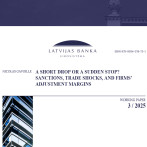Manufacturing continues up, despite problems and uncertain future
In October, a slight growth in manufacturing was observed, which is a very positive development given the unfavourable circumstances in the external markets. Yet an alarm is sounded by the deterioration of efficiency and cost-effectiveness in the sector.
According to the data of the Central Statistical Bureau, the amount of manufacturing output in October 2014. grew by 0.3% month-on-month (seasonally adjusted data). The year-on-year increase was at 1.5% (calendar-adjusted data).
Month-on-month growth was posted, for a second consecutive month, by the food industry (+0.6%), thus confirming the previous observation that the impact of the Russian economic sanctions is rather limited even on the sector affected most severely. Meanwhile, the wood industry in October (-0.7%) stepped back slightly from its historical maximum reached in September, yet the output level is still high. After a period of dropping output that lasted almost six months, the production of construction materials in October posted growth (+5.4%), thus somewhat allaying the previously voiced concern that the drop in the output of this sub-branch may point to accumulating problems in the construction sector. Of the other sub-branches, furniture production (+6.1%) deserves mention for the maximum reached in the post-crisis maximum and so does the production of power equipment (+2.7%), where the highest output has been reached within the framework of available data (since 2000).
Given its great dependence on export (over 60% of manufacturing products are sold in the export markets) the Latvian manufacturing has been demonstrating an admirable ability to resist unfavourable circumstances, which its enterprises face in the external environment because of the weak growth in the euro area and the attendant weak demand; the weakening of the Russian economy and economic sanctions, throughout the year. The above are the main reasons why the rise in manufacturing output this year has been close to zero. At the same time, the non-financial investment made by the sector in the first three quarters of this year has increased 34.1% year-on-year. That serves as an indication that the sector will be ready to increase production output also when the external demand resumes.
The recently published business financial indicators for 2013 (data are available also on the first six months of 2014, but there the surveyed sample is substantially smaller, which has a significant effect on the credibility of data) casts some doubt on the potential for the sector’s growth in the medium term. There is still positive news, however. Looking at the liquidity and coverage indicators, they are gradually improving, pointing to increased financial stability of enterprises. As the profitability of manufacturing enterprises resumes in the post-crisis period, their ratio between own capital and borrowed funds is increasing.
At the same time, the deterioration of efficiency and cost-effectiveness is slightly alarming. The turnover of all assets in 2013 dropped slightly year-on-year. That indicates that the effectiveness of use of the assets at the disposal of enterprises has deteriorated somewhat. The commercial cost-effectiveness of manufacturing enterprises after the payment of taxes in 2013 has dropped to 1.4% (in contrast to the 2.3% average in the period between 2010 and 2012), which signals a declining profitability in the sector.
Of course, the financial analysis indicators should be analyzed in context and they cannot be viewed separately from developments in the sector. A substantial impact on the financial indicators of the sector is left by the sub-branch of metal production in which a number of problems was observed in 2013, but a drop in cost-effectiveness indicators in 2013 is observed also in a number of other manufacturing sub-branches. There may be many different reasons for the drop in cost-effectiveness in 2013, yet, in my opinion, these indicators sound an alarm, indicating that manufacturing growth may be limited in the medium term. It is clear that manufacturing growth will continue in 2014 and 2015 – on account of both an increased existing full load capacity (incl. possible resumption of the operations of "KVV Liepājas metalurgs) and creating new capacities, for at the moment, projects are being carried out in the sector, which will boost the total capacity of the sector to a new level. Yet in the medium term, the sector businesses have to consider means of improving the cost-effectiveness indicators for manufacturing. The economic policy makers may have to inventory those instruments that may promote such outcomes.
The expenditure of Latvian manufacturers for power against turnover is among the highest in the European Union (a partial explanation may be the structure of Latvian manufacturing: much of it is relatively energy-intensive). The rises in wages in the last three years also has been hovering around the 5% mark on average. Thus in Latvian manufacturing, the significance of increased operation efficiency rises with each passing year. It can therefore be expected that in the medium term, further growth will be achieved only by increasing productivity, reducing energy losses and introducing new, innovative products and processes.
Textual error
«… …»






